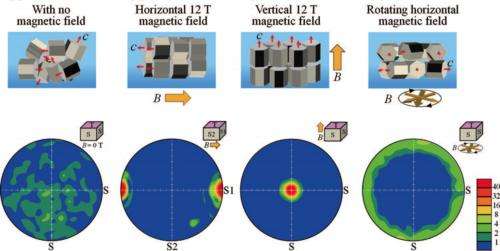Researchers show how to keep cathode material 'in line' to enhance battery performance

The ever-increasing market for portable electronic devices such as laptops, cell phones and MP3 players has resulted in an equally heavy demand for secondary batteries—more commonly known as rechargeable batteries—Lithium-ion (Li-ion) being among the most popular.
Scientists and engineers worldwide are seeking ways to improve the power density, durability and overall performance of Lithium-ion batteries, and in a recent paper in the AIP Publishing journal APL Materials, Japanese researchers from a public-private team report an advance in Li-ion battery technology that they describe as a major breakthrough. They fabricated a cathode (positive electrode) of lithium cobalt oxide (LiCoO2) in which the compound's individual grains are aligned in a specific orientation. The researchers claim that this yields a significantly higher-performing battery than one with a randomly-oriented LiCoO2 cathode.
Primary, or non-rechargeable, batteries and secondary batteries both produce current through an electrochemical reaction involving a cathode, an anode, and an electrolyte (an ion-conducting material). However, apply an outside current to a secondary battery and the negative-to-positive electron flow that occurs during discharge is reversed. This allows the battery to restore lost charge.
"In a lithium-ion battery, lithium ions move from the anode to the cathode during discharge and back when charging," said Tohru Suzuki, a co-author on the APL Materials paper. "The material in the cathode has a layered structure to facilitate intercalation [insertion] of the lithium ions; if the structure is oriented in a specific fashion, the lithium ions have better access to the lattice and, in turn, charge-discharge performance is improved."
Using a rotating magnetic field, the researchers were able to fabricate the ideal textured microstructure of the individual LiCoO2 grains making up the cathode: a perpendicular alignment of the c-plane (the vertical side) and a random orientation of the c-axis. Unlike cathodes where the microstructures in both the c-plane and c-axis are randomly oriented, the specialized grains allow easy access for lithium ions while relaxing the stress associated with intercalation.
"This yields a highly efficient flow of electrons in both directions," Suzuki said.
More information: The article, "Ideal design of textured LiCoO2 sintered electrode for Li-ion secondary battery" by Hideto Yamada, Tohru S. Suzuki, Tetsuo Uchikoshi, Masato Hozumi, Toshiya Saito and Yoshio Sakka appears in the journal APL Materials. dx.doi.org/10.1063/1.4824042
Provided by American Institute of Physics





















